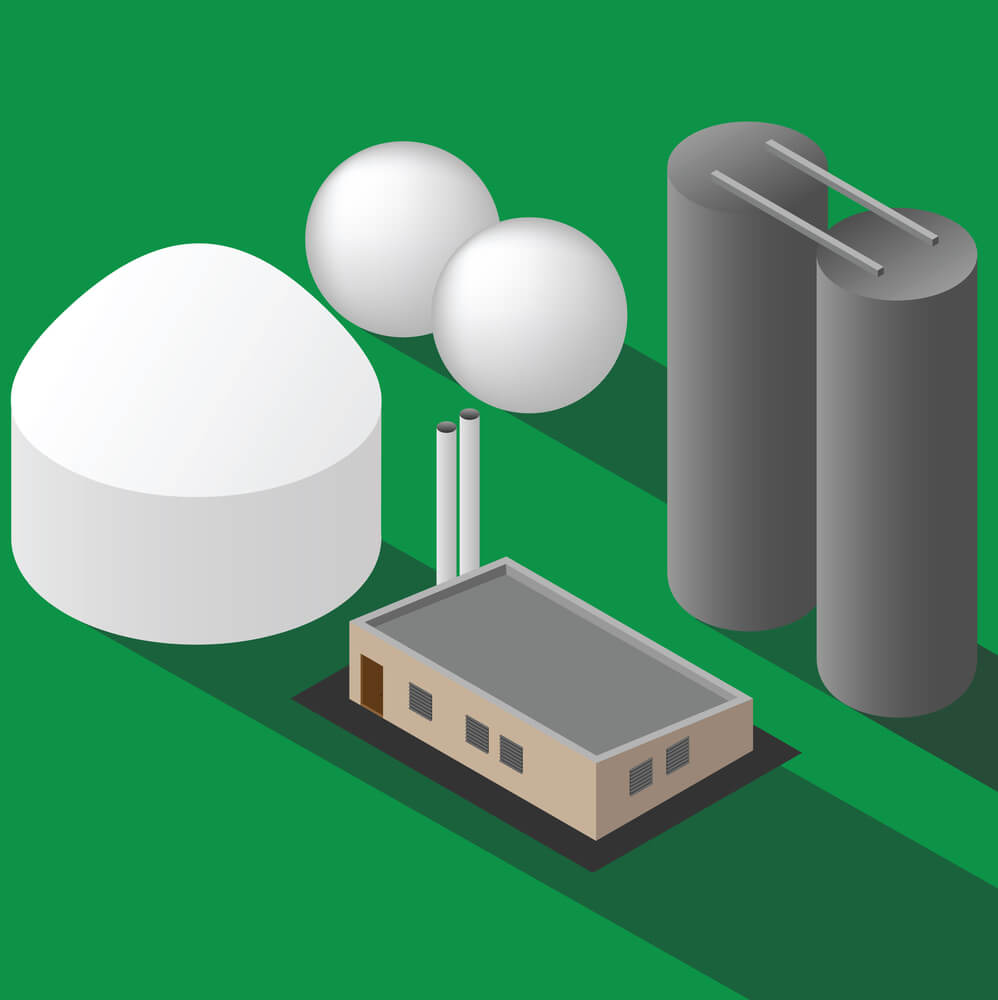Biogas is a sustainable form of energy that is produced by the breakdown of organic waste.
We can use it for various purposes like electricity production, heat generation, fuel & so on.
Biogas plants can significantly reduce greenhouse gas emissions.
This is because they use these harmful gases to produce clean energy.
As per World Biogas Association, Biogas has the potential to reduce global climate change emissions by 20%.
This article will explore what Biogas is, how it’s produced, and its benefits and applications!
Biogas – what is it & what is it made of?
What is called Bio-Gas?
Biogas is a type of biogenic gas that the conversion of organic material can produce into methane by anaerobic bacteria.
What is Biogas made of?
Biogas is generally made of
60-75% Methane (CH4)
25-35% Carbon dioxide (CO2)
0-1% Nitrogen (N2)
0-1% Hydrogen (H2)
0-1% Hydrogen sulfide (H2S)
0-3% Carbon monoxide (CO)
0-2% Oxygen (O2)
We can use the Biogas produced for electricity production or to power vehicles.
It’s highly sustainable as it does not produce any greenhouse gases!
Biogas production process
Typically, Biogas is created through a process known as anaerobic digestion.
Anaerobic digestion is the degradation of organic materials in the absence of oxygen.
It releases gas as a by product of the process.
To produce the biogas biomass or organic material.
This can come from food waste, animal manure, or plant matter such as rice husks and corn stover.
You need to mix the waste with water in a digester.
Then anaerobic fermentation happens because of anaerobic bacteria present.
It produces gas that can either be captured or combusted into electricity.
The more organic materials present inside the digester lead to higher production rates of Biogas.
It’s because bacteria’s metabolism rate increases when they’re provided with more food particles.
Depending on the output needed, the biogas production plants of various types.
It differs in the process involved, sizes, shapes & type of organic material used.
It is broadly categorized into the following types.
Batch plants –
You need to feed the plant with organic material in one go & it produces Biogas over some time
Continuous plants –
The plant can produce Biogas 24 hours, without any interruption.
Semi-batch plants –
It operates continuously or as a batch depending on the type of material used for processing.
What sort of waste can be used to produce Biogas?
Biogas can be produced from any waste with high organic content, such as manure and rotting leaves.
It can also be produced by industrial food waste or sewage sludge from wastewater treatment plants.
The process is not restricted to just one form of material. It simply depends on the available resources & type of digester used.
Here is a four such wastes that you can use to produce Biogas.
- Livestock manure
The Livestock manures include manures of
Cattle
Buffalo
Pig
Chicken
You can use it for anaerobic digestion to create Biogas. Apart from bio-gas, it yields nutrient-rich digestate.
You can use this as organic fertilizer.
2. Agricultural wastes
Farming, agricultural, and food processing plants produce a lot of organic waste that you can use for biogas production.
They have a high untapped potential to generate energy & reduce greenhouse gasses.
This includes
Rice straws
Corn stalks
Cotton stalks
or any other type of plant material that has high levels of biomass content.
3. Industrial wastewaters
Wastewater treatment facilities generate huge amounts of sludge which you can convert to Biogas.
The wastewater from these facilities contains sewage as well as industrial effluents like detergents and paints in the form of solid particles called sludge solids (SS).
We can also use these to produce Biogas in a biogas plant.
However, the presence of heavy metals may reduce the efficiency of the system.
4. Sewage Sludges
Sewerage treatments process large volumes of water with a heavy load on
Biological Oxygen Demand ( BOD) and
Chemical Oxygen Demand (COD).
Sewage sludge is a byproduct of liquid effluent from this sewage treatment process.
It has high levels of organic content.
Eventually, the biogas plants can convert these to Biogas via anaerobic digestion.
Uses of Biogas
As one of the most reliable forms of renewable energy, we can use Biogas in various sectors.
It has a broad spectrum of uses including heat generation, producing electricity, as a fuel, waste management, and so on.
Cooking & Heating –
Biogas can reduce dependency on cow dung for cooking fires which tends to pose health hazards.
Biogas replaces other fuels such as wood, charcoal, etc… Thus reducing deforestation and other environmental hazards.
Electricity generation-
You can use Biogas for electricity generation through biogas plants.
It is the most efficient form of renewable energy available today, with an output that ranges from 18-24%.
It also eliminates dependency on fuel such as diesel, LPG gas, etc., which are costly to purchase.
Biotechnology (BT) companies have introduced innovations for
–Better conversion efficiency and
-Less emission of pollutants.
They have upgraded the design of the conventional biogas plant into a more stable semi-continuous or continuous system.
You can use these upgraded plants depending on the type of material processed.
This can reduce operating costs without affecting production capacity.
This way, environmental pollution is also reduced significantly.
Waste management
With increasing population density in urban areas due to rural-urban migration, the problem of waste management has become a major issue.
We can use the biogas production from wet wastes (kitchen and garden) as an additional source of fuel to generate electricity or power plants.
This in turn will reduce reliance on conventional fuels such as coal.
Sewage treatment systems can also use biomethanation process.
Here biodegradable organic matter like kitchen and garden garbage is converted into methane gas.
You can efficiently utilize the generated natural gas for cooking purposes.
If not necessary, it’s exported to grid roads/to CNG stations.
Hence, it reduces the demand for other fossil fuel-based transport modes lowering levels of pollution.
As fuel
It’s an excellent choice for running vehicles like automobiles, ships, buses, etc.
It also reduces emissions by up 90% over petrol combustion engines when used as transport fuel at low compression ratios.
We can also use Biogas to fuel Fuel cell vehicles.
For example, BMW has been using fuel-cell technology in their Hydrogen-Fuelled Plug-in Hybrid Vehicle (called the “HFBX”).
This vehicle gets up to 100 miles per gallon and achieves a range of 435 miles on one tank of gas!
This is an eco-friendly alternative that reduces our dependency on conventional fuels such as coal.
As a fertilizer
The residue or the digestate is the byproduct of biogas production.
You can use it as a fertilizer for plants in agricultural fields.
This reduces the use of chemical fertilizers that often leads to toxic run-offs and other environmental hazards.
Conclusion
With all these practical uses, Biogas has a lot to offer. It is not only renewable but also sustainable and environmentally friendly.
Biogas is a viable substitute for other sources of energy that have harmful effects on the environment.
You can also use it as an alternative to fossil fuels, and it doesn’t pollute air or water as many others do.
If you’re looking for ways to reduce your carbon footprint, Biogas might just be the answer!



